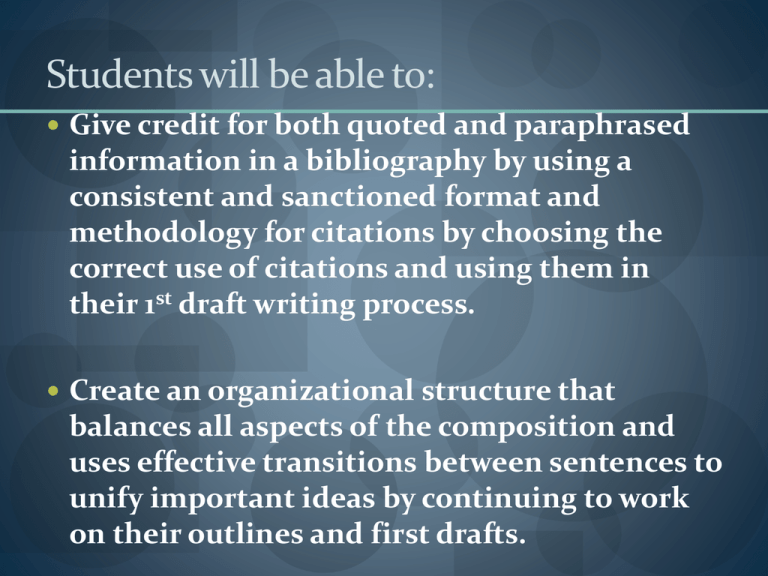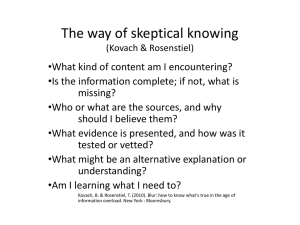
Students will be able to:
Give credit for both quoted and paraphrased
information in a bibliography by using a
consistent and sanctioned format and
methodology for citations by choosing the
correct use of citations and using them in
their 1st draft writing process.
Create an organizational structure that
balances all aspects of the composition and
uses effective transitions between sentences to
unify important ideas by continuing to work
on their outlines and first drafts.
CITATIONS IN YOUR PAPER
Giving Credit to Your Sources
MLA format follows the author-page method
of in-text citation.
This means that the
author's last name and
the page number(s) from
which the quotation or
paraphrase is taken must
appear in the text, and a
complete reference should
appear on your Works
Cited page.
For
Example:
(les, 578)
Acceptable Citations
For example:
Wordsworth stated that Romantic poetry was
marked by a "spontaneous overflow of powerful
feelings" (263).
Romantic poetry is characterized by the
"spontaneous overflow of powerful feelings"
(Wordsworth 263).
Wordsworth extensively explored the role of
emotion in the creative process (263).
Choose the MLA in-text citation that is
handled correctly.
a. An interviewer
explains that country
musician Merle Haggard
“is not happy about
much that is currently
being packaged as
‘country.’ He will name
no names but is
manifestly disgusted by
most of what’s on the
charts” (Hentoff 163).
b. An interviewer
explains that country
musician Merle Haggard
“is not happy about
much that is currently
being packaged as
‘country.’ He will name
no names but is
manifestly disgusted by
most of what’s on the
charts” (163).
Correct!
The
interviewer
was never
named in the
beginning of
both choices.
So the reader
does not know
who is given
credit for this
information
until the
citation at the
end of the
quote.
a. An interviewer explains that
country musician Merle Haggard “is
not happy about much that is
currently being packaged as ‘country.’
He will name no names but is
manifestly disgusted by most of
what’s on the charts” (Hentoff 163).
TRY AGAIN!
Choose the MLA in-text citation that is
handled correctly.
A. Human beings
have been
described by
Kenneth Burke as
"symbol-using
animals" (3).
B. Human beings
have been
described by
Kenneth Burke as
"symbol-using
animals" (Burke 3).
Correct!
The writer
was
already
described
in the
sentence
before the
citations
so it is not
needed to
be added
again.
A. Human beings have been
described by Kenneth Burke
as "symbol-using animals"
(3).
Also correct:
Human beings have been
described as "symbol-using
animals" (Burke 3).
BUT WHAT ABOUT THIS?
Choose the MLA in-text citation that is
handled correctly.
a. Als describes
Cat Power as “a
storyteller . . .
[who] cares more
about how she
says something
than about what
she says.” (148)
b. Als describes Cat
Power as “a
storyteller . . .
[who] cares more
about how she says
something than
about what she
says” (148).
b. Als describes Cat Power as
Correct!
The
period
goes after
the
citation.
“a storyteller . . . [who] cares
more about how she says
something than about what
she says” (148).
THE REAL CHALLENGE
The student is quoting from page 281 of the following
article:
Mead, Rebecca. “Sex, Drugs, and Fiddling.” Da Capo Best
Music Writing 2000. Ed. Peter Guralnick and Douglas
Wolk. Cambridge: Da Capo, 2000. 281-93. Print.
a. One startling description of fiddler Ashley MacIsaac
begins, “Although wrecking a hotel room is standard
rock-star behavior, it is unusual for the instrument of
destruction to be a bucketful of freshly cooked
lobsters” (Mead 281).
b. One startling description of fiddler Ashley MacIsaac
begins, “Although wrecking a hotel room is standard
rock-star behavior, it is unusual for the instrument of
destruction to be a bucketful of freshly cooked
lobsters” (Guralnick and Wolk 281).
a. One startling description
Correct!
Mead is
the author
and
Guralnick
and Wolk
are the
editors.
of fiddler Ashley MacIsaac
begins, “Although wrecking a
hotel room is standard rockstar behavior, it is unusual
for the instrument of
destruction to be a bucketful
of freshly cooked lobsters”
(Mead 281).
Mead, Rebecca. “Sex, Drugs, and Fiddling.” Da Capo Best Music Writing
2000. Ed. Peter Guralnick and Douglas Wolk. Cambridge: Da Capo, 2000.
281-93. Print.
REMEMBER TO USE CITATIONS
AFTER STATING YOUR
EVIDENCE!
1st
State the
Claim:
Today, Americans are too self-centered.
Even our families don't matter as much
anymore as they once did. Other people
and activities take precedence.
2nd Give Evidence: In fact, the evidence shows that most
American families no longer eat together,
preferring instead to eat on the go while
rushing to the next appointment (Gleick
148).
3rd Comment on
the evidence to
show how it
supports the
claim:
Sit-down meals are a time to share and connect
with others; however, that connection has
become less valued, as families begin to prize
individual activities over shared time,
promoting self-centeredness over group
identity.












